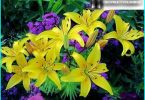The contents
Before reading further, we invite you to see the video:
How to propagate thuja?
There are three main ways of reproduction TUI:
- prepared seeds;
- cuttings (branches);
- prepared for planting seedlings.
You long to experiment with different ways, but in any case, you will focus on the most rational and practical – propagation using cuttings.
Growing from seed: long and troublesome
Why not made to grow th from seed? It’s simple: to a seedling suitable for planting in open ground need not less than 5 years, besides in the process of growth the tree will lose all of its varietal characteristics and will turn into a regular wild plant. The only plus – maximum preparation of seedlings to local, specific conditions of growth.
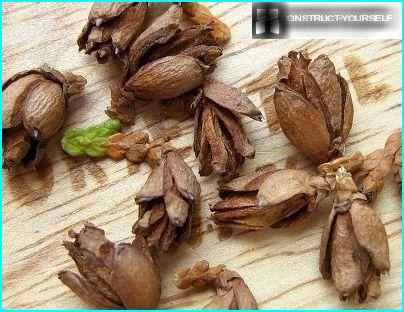
Arborvitae seeds unpretentious to the soil, but for planting it is better to use loose and fertile soil, consisting of sand, coniferous and leaf
For planting select good healthy seeds that had lain all winter under the snow, as the process of stratification hardens them and prepares for further development in similar climatic conditions. In the spring put the seeds in boxes with a nutrient soil, sprinkle a layer of soil mixed with pine sawdust. The young seedlings should be closely monitored: to cover out of direct sunlight, clean from weeds, regularly moisturize, feed with a weak solution of fertilizer. And only in the fifth year of the grown seedlings can be planted in a permanent place.
Arborvitae from cuttings is the most effective way
Experienced gardeners know that most conifers well propagated by cuttings. Among them, different varieties of juniper, fir, pine – that is, plants that thrive even in the harsh Northern climate. It is also important that when Chernozem breeding trees retain their belonging to a particular class.
To separate the shoots usually choose April. Perfect cuttings obtained from shoots of 2-3-year growth, with the upper part of the crown. It is better not to use a pruner, and try to pull the stalk manually. The length of the detachable part is about 20 cm When pulling on the end of twigs will remain a piece from wood, small «heel», rich in nutrients. For the collection of planting material is suitable and June when the plant is undergoing a second period of growth, but the June preparations will be ready for the season later, as the current year they just «sleep».
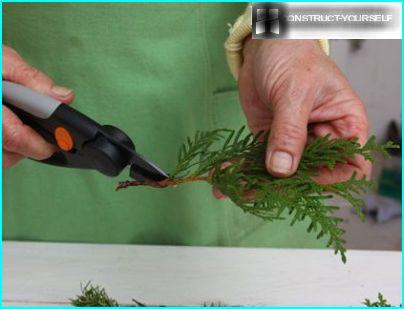
Pine needles and small twigs from the lower part of the cuttings must be removed that when in contact with moist soil or sand did not decay
To decontaminate the young shoots, put them for a few minutes in a weak solution of manganese, and then soaked for a day in «Kornevina» or similar stimulant.
For planting suitable boxes with river sand or a mixture of sand and garden soil, placed in a suspended state (as a variant – to place bricks, rocks, boards). The bottom of the drawer perforatum that water easily flowed and did not stagnate, and to the roots constantly received oxygen. Then spread a drainage layer of small pebbles. Sand before using is better to boil in a galvanized bucket or tank, and then soak in a 3% solution of potassium permanganate. Bury the cuttings only 1.5-2 cm, carefully sealing the ground and drenched with water. Watch, that after each subsequent irrigation water has not washed away the soil, and the handle remained in his place.
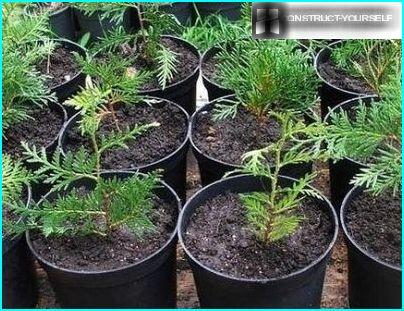
For summer or winter seedlings TUI suitable boxes and ordinary flower pots of the appropriate size of the volume should be enough that the roots were not closely
The room in which to spend the winter, the boxes with the seedlings must be shaded and warm. Rooting of shoots going well at the temperature of +18-22?C, in a humid environment. If frosts are forecast, for insulation you can use greenhouse plastic film. The first two months, the daily spraying, in extremely hot conditions twice a day – morning and evening.
Early autumn is the time of the landing of rooted cuttings in open ground on a dedicated garden bed or in pots set in the greenhouse. The roots by this time reached a length of 8-10 cm Please note on the soil – thuja prefers acidic soil mixed with peat. Rearing of seedlings occurs 2-3 years, minimal maintenance is watering, weed removal, regular weeding.
How to choose seedlings?
If there is no time, not enough patience or you can’t wait to decorate the area around the house beautiful plants – buy already ready seedlings. Sometimes offer instances, grown in the neighbouring cottages. If you trust the sellers, you can buy and they have, but assorted products with good quality better to buy in professional nurseries. Among the hundreds of samples you can choose healthy, tempered, resistant to diseases, accustomed to local climatic conditions, the plant.
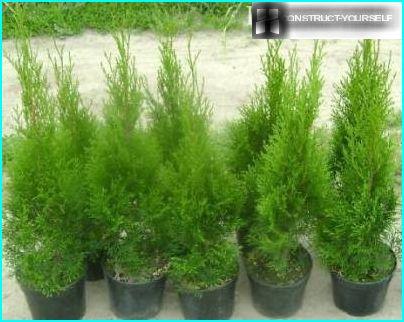
Seedlings from the nursery are age and size: you can buy the small and own they «to bring» prior to the period of the landing, but you can buy large, ready for the decorative work on the site
Please note the conditions in which the plants are contained: does the temperature sufficiently moistened the soil in the pots. Perhaps, regular watering is not carried out, and implemented the sample watered only for the day of the sale. Needles should sit firmly, not to crumble, look bright and strong. On the stem and branches should be free of spots, stains, and other signs of diseases.
Bringing seedlings home as quick as you can transplant them to a shaded area and watered.
Features spring planting in the ground
Unpretentious thuja perfectly survives at any convenient for gardening time of the year, but experienced growers recommend planting arborvitae in the spring, thereby tying the life cycle of plants to the biological clock.
Before planting pre-define the location convenient to the plants. When designing a landscape project, remember that thuja likes lightly shaded places. In the bright areas it withers and harder to tolerate cold, in the dark places poorly developed and loses its decorative qualities. Light shade, closed from the wind location close groundwater – these are the factors that contribute to the correct growing arborvitae.
Step by step guide to planting:
- tearing a deep hole – about 70-80 cm deep and 90-100 cm in diameter so that it freely entered a clod of earth with a seedling;
- on the bottom of the pit pour a little of the soil with organic fertilizers, for example, often apply a mixture of 2-3 kg of wood ash for the 1m? soil;
- put the seedling into the hole, being careful not to damage the soil ball with roots, and with root collar at the ground level;
- mix garden soil with peat and sand in equal proportions, fall asleep, easy stamps.
Spacing between plants depends on the variety as crops of different varieties are different sizes. Miniature types it is better to have a distance of not more than 1 meter, large – up to 5 meters. Suppose the Brabant cultivar reaches a height of 10-15 m and crown diameter of 4 m, that is, to develop the full required maximum space. When planting hedges, regardless of type and size, the plants are planted at intervals of 1 m.
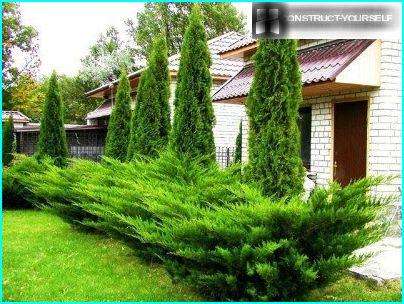
Grade Brabant is a real godsend for landscape designers. With the help of special techniques and options haircuts can be adjusted in the form of plants to create hedges and a combined composition
After planting watering is necessary and the primary dressing. As fertilizer often use natural growth promoters, such as «Appin» and its analogs. Substances included stimulants help plants take root faster, protect them from diseases. In the spring, the effective half-fertilizing with potassium and phosphorus with a break of 10-14 days.
Watering in the spring depends on the weather and amount of rain. In the hot and dry period, the plant needs watering at least twice a week, cool in the spring and once is enough. If the rainy season, additional watering is not required.
Consider the main points of growing arborvitae that need to pay particular attention to watering, fertilizing, mowing and preparing for the winter period.
Watering and sprinkling
Mature plants, like the seedlings love moist environment and it is better if the water will flow from all sides, not only from the soil. Regular watering is a necessary condition for maintaining plants in «good physical shape». A sufficient amount of moisture is immediately reflected on the appearance of the thuja – branches are flexible and the needles – brilliant, more saturated shade.
Minimal watering one bucket of water (about 10 l) in the root area once a week during dry periods – 2-3 times a week. In a drought the lack of moisture thuja reacts immediately: the tip of the crown yellow, a large number of cones, is not always appropriate for decorative effect. Best time of day for watering is early in the morning or evening.
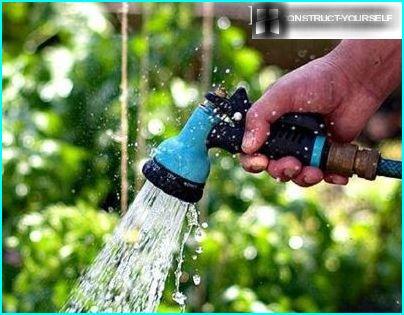
Watering thuja, especially seedlings, should be very careful not to wash soil from the root collar area, which is on the same level with the surface of the soil
Not less abundant watering arborvitae likes a sprinkling – spraying the crown with a spray bottle or hose with a special nozzle. Water washes away dust, appearance of the tree is updated, thuja becomes fresh and clean, and the air there is a pleasant smell of pine. Don’t be afraid once again to spray the fifth, irrigation 1-2 times a day is good for her.
The fertilization and mulching
Thuja, like many ornamental plants, need regular feeding. On fertilizer it reacts faster growth (although the TUI is one of the most slow-growing cultures), splendor, luster and bright color of the needles. Often to fertilize plants is not required, it is enough 1-2 times early in the season or in the summer. In addition to the traditional compost you can use a special fertilizer for conifers.
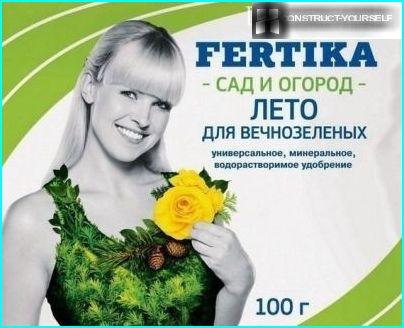
Fertilize thuja economically: gold bag complex fertilizers «Vertica» for feeding in conifers in summer is 90-100 rubles
Experienced gardeners recommend a universal product «Vertica» for evergreen plants of the Finnish manufacturer. «Particu spring» applied to the soil when loosening – spread in the region of the trunk and carefully dug up together with the top layer of soil. Dosage – 35-40 g per 1m? soil. Summer variant is dissolved in water and used in irrigation.
Tree trunks need additional cleaning and loosening. For weed control, moisture retention and fertility improvement area around the trunk mulch with compost or sawdust. For decorative purposes the ground cover painted wood chips or nut shells.
Cropping and artistic haircut
The first two years of thuja should be left alone, to let her finally to take root, to follow the growth rate, to determine its needs. In the third year you can start pruning the crown.
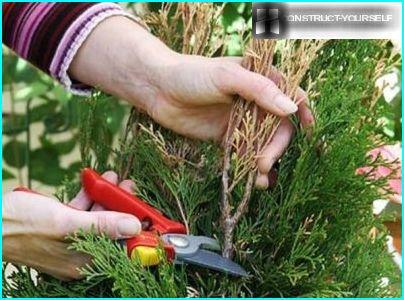
First and foremost, relieve the crown withered, flabby, injured during wintering twigs, and then decide whether additional prorezheniye: loss of density effect on the decorative properties
There are a few rules of proper pruning:
- the basic procedure is carried out in April, then throughout the summer, until the cool days, adjust the shape of the crown;
- suitable for cutting dry weather;
- before cutting you should remove the dry or diseased branches and to improve air circulation to slightly thin out the plant, sacrificing and healthy shoots;
- to maintain the stability of the selected art forms should remove all shoots of annual growth;
- if you need increase only in width, cut off the top crown.
Artistic grooming is to give the plant a defined, often geometric forms – sphere, pyramid, cube, columns.
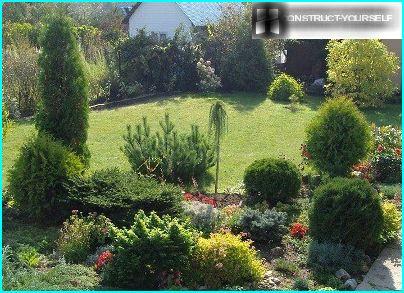
Common in suburban areas, the composition with the participation of conifers – several design options arborvitae and surrounded by flowers and decorative grasses
Skilled craftsmen managed to transform coniferous plants into figures of animals or fantasy creatures. Inexperienced, novice gardeners it is better to start with simple compositions – low hedges, lawn «balls» or simple bunk cascades.
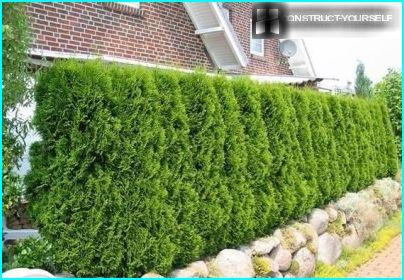
A hedge of arborvitae in the country performs several useful functions: protects a suburban area from intruders is a decorative element and absorbs street noise
Prepare TUI for the winter
In middle and Northern latitudes of Russia for decorating a country sites select varieties of Western arborvitae is the most hardy and unpretentious, nevertheless, they should also be prepared for cold and snowy winter. The development, albeit slow, in the harsh period provides abundant autumn irrigation.
Young immature trees the first few years need for additional insulation. As a covering material use non-woven spunbond or thick greenhouse film is a transparent cocoon, keeping warm, miss the sun’s rays for photosynthesis. In specialized stores you can buy special covers. To protect the roots use fallen foliage, which is cleaned in the spring, after thawing of the top soil.
Mature trees enough to protect from snow and strong wind. So that the snow does not accumulate on the branches, pull them gently to the trunk. Snow deposits favored the appearance of mold, so it is better to promptly remove.
If you learn to properly care for a thuja and skillfully use her slow growth, then get the perfect plant for decorating paths, rockeries, Alpine gardens and flower beds.



